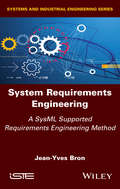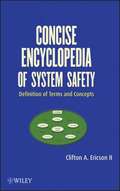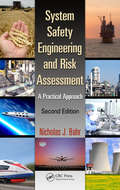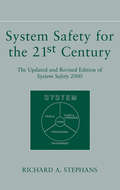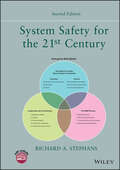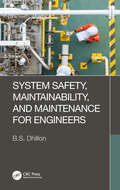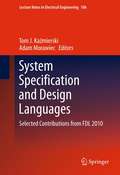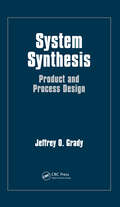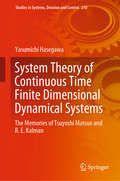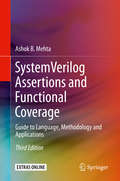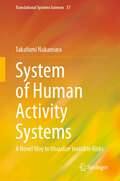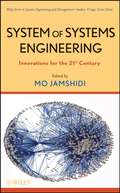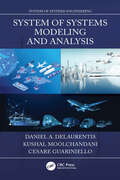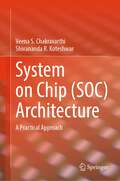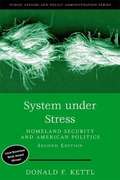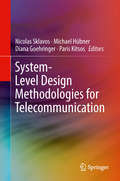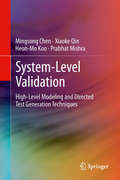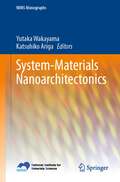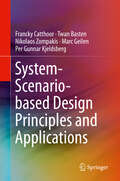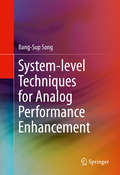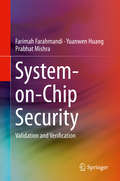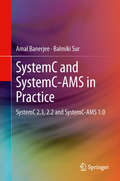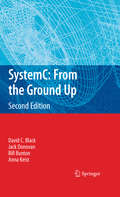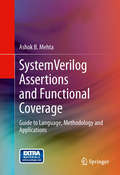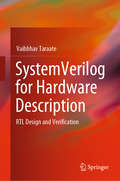- Table View
- List View
System Requirements Engineering: A SysML Supported Requirements Engineering Method
by Jean-Yves BronThe book deals with requirements engineering in the context of System Engineering. He proposes a method to guide this activity engineering. The method is supported by the SysML modeling language. A first chapter aims to present the context and the associated definitions, to position the requirements engineering in the processes system engineering, to define the modeling and its contributions, and to make the link with the management of IS projects. The second chapter is devoted to the proposed method for implementing the requirements engineering subprocesses. Each of the 8 activities the component is first described before specifying how the SysML language can be exploited to achieve it effectively. Proposal for a book Please fill out the questionnaire below and send it back to Chantal Menascé: c.menasce@iste.co.uk The 3rd chapter is an application of the method to define the needs of the stakeholders of a system. The example is built on the basis of the RobAFIS'2018 competition. The 4th chapter continues the application of the method in the continuity of the IS processes to define the requirements of the same system. The appendices present at the same time a toolbox to realize the engineering of the requirements but also the complete results of engineering in Chapters 3 and 4.
System Safety
by Clifton A. Ericson IiThe first comprehensive reference work covering safety professional terminology A convenient desk reference designed to fill a serious gap in the system safety body of knowledge, the Concise Encyclopedia of System Safety: Definition of Terms and Concepts is the first book explicitly devoted to defining system safety terms and concepts and designed to help safety professionals quickly and easily locate the definitions and information which they need to stay abreast of research new and old. Definitions for safety-related terminology currently differ between individual books, guidelines, standards, and even laws. Establishing a single common and complete set of definitions for the first time, with examples for each, the book revolutionizes the way in which safety professionals are able to understand their field. The definitive resource devoted to defining all of the major terms and concepts used in system safety and reliability in a single volume, Concise Encyclopedia of System Safety is the go-to book for systems safety engineers, analysts, and managers as they encounter new terms, or need an exact, technical definition of commonly used terms.
System Safety Engineering and Risk Assessment: A Practical Approach, Second Edition
by Nicholas J. BahrWe all know that safety should be an integral part of the systems that we build and operate. The public demands that they are protected from accidents, yet industry and government do not always know how to reach this common goal. This book gives engineers and managers working in companies and governments around the world a pragmatic and reasonable approach to system safety and risk assessment techniques. It explains in easy-to-understand language how to design workable safety management systems and implement tested solutions immediately.The book is intended for working engineers who know that they need to build safe systems, but aren’t sure where to start. To make it easy to get started quickly, it includes numerous real-life engineering examples. The book’s many practical tips and best practices explain not only how to prevent accidents, but also how to build safety into systems at a sensible price. The book also includes numerous case studies from real disasters that describe what went wrong and the lessons learned.See What’s New in the Second Edition: New chapter on developing government safety oversight programs and regulations, including designing and setting up a new safety regulatory body, developing safety regulatory oversight functions and governance, developing safety regulations, and how to avoid common mistakes in government oversight Significantly expanded chapter on safety management systems, with many practical applications from around the world and information about designing and building robust safety management systems, auditing them, gaining internal support, and creating a safety culture New and expanded case studies and "Notes from Nick’s Files" (examples of practical applications from the author’s extensive experience) Increased international focus on world-leading practices from multiple industries with practical examples, common mistakes to avoid, and new thinking about how to build sustainable safety management systems New material on safety culture, developing leading safety performance indicators, safety maturity model, auditing safety management systems, and setting up a safety knowledge management system
System Safety for the 21st Century
by Richard A. StephansSummarizes the current state of "front-end" risk-control techniquesMany approaches to risk control are possible. However, only through careful reading, evaluation, and study can one make the best choice of a practical philosophy for a system safety program. The goal is to apply the best scientific and engineering principles in the best way, resulting in the soundest and safest possible system.System Safety for the 21st Century provides in-depth coverage of this specialized discipline within the safety profession. Written for both technical and nontechnical reference, this clearly organized text serves as a resource for both students and practitioners. It gives basic and essential information about the identification, evaluation, analysis, and control of hazards in components, systems, subsystems, processes, and facilities.Integrating the changes to the field that have occurred since publication of the first edition, this revised and expanded resource offers:* Logical progression from basics to techniques to applications* New focus on process safety not found in other texts* A new and unique section on professionalism for system safety and other safety practitioners* Presentation of both system safety scope and essentials* Consistent chapter format for easy learning includes an introduction and summary for each chapter* Review questions reinforcing important points* A combination of basis requirements with practical experience* Information on selected techniques to assess hazards and provide management oversight* An updated section on protecting against external events in the light of the global terrorist threat* Critiques of existing systems, including those of the Department of Defense and the* Department of EnergyRelevant to industry, academia, and government, System Safety for the 21st Century is an essential resource for anyone studying or implementing proactive hazard identification and risk control techniques and procedures.
System Safety for the 21st Century
by Richard A. StephansSystem Safety for the 21st Century Explore an authoritative and complete exploration of basic and advanced concepts in system safety engineering The Second Edition of System Safety for the 21st Century delivers an authoritative primer on the identification, evaluation, analysis, and control of hazards to people, components, sub-systems, systems, processes, and facilities. The book offers readers a complete discussion on techniques within system safety, the discipline on process safety, as well as a comprehensive treatment on professionalism within the safety??industry. This new edition applies the concepts of system safety to medical disciplines and medical devices, offering readers the potential to have a significantly positive impact on the standing of American medical safety in the world. The latest edition also includes: A brand-new chapter on the risk management with current international and??U.S. government standards New material on process safety including EPA and OSHA implementation and??external reviews An Instructor Solutions Manual that includes course content and 30??chapters of review questions and answers Further clarifications on difficult concepts from the First Edition with updated??appendices and references Relevant to academia, industry, and government, System Safety for the 21st Century is an essential resource for anyone studying or implementing and managing proactive hazard identification and risk control techniques and procedures.
System Safety, Maintainability, and Maintenance for Engineers
by B.S. DhillonThe safety, maintainability, and maintenance of systems have become more important than ever before. Global competition and other factors are forcing manufacturers to produce highly safe and easily maintainable engineering systems. This means that there is a definite need for safety, maintainability, and maintenance professionals to work closely during the system design and other phases of a project, and this book will help with that. System Safety, Maintainability, and Maintenance for Engineers presents, in a single volume, what engineers will need when designing systems from the fields of safety, maintainability, and maintenance of systems when they have to all work together on one project and it provides information that the reader will require no previous knowledge to understand. Also offered are sources in the reference section at the end of each chapter so that the reader is able to find further information if needed. For reader comprehension, examples along with their solutions are included at the end of each chapter. This book will be useful to many people including design engineers; system engineers; safety specialists; maintainability engineers; maintenance engineers; engineering managers; graduate and senior undergraduate students of engineering; researchers and instructors of safety, maintainability, and maintenance; and engineers-at-large.
System Specification and Design Languages
by Tom J. Kaźmierski Adam MorawiecThis book brings together a selection of the best papers from the thirteenth edition of the Forum on specification and Design Languages Conference (FDL), which was held in Southampton, UK in September 2010. FDL is a well established international forum devoted to dissemination of research results, practical experiences and new ideas in the application of specification, design and verification languages to the design, modelling and verification of integrated circuits, complex hardware/software embedded systems, and mixed-technology systems.
System Synthesis: Product and Process Design
by Jeffrey O. GradyUnlike most engineers, system engineers focus on the knowledge base needed to develop good systems in a cross-functional fashion rather than deeply on isolated topics. They are often said to be a mile wide and an inch deep in what they do know. System Synthesis: Product and Process Design provides insight into complex problems, focusing on the boun
System Theory of Continuous Time Finite Dimensional Dynamical Systems: The Memories of Tsuyoshi Matsuo and R. E. Kalman (Studies in Systems, Decision and Control #250)
by Yasumichi HasegawaThis book discusses the realization and control problems of finite-dimensional dynamical systems which contain linear and nonlinear systems. The author focuses on algebraic methods for the discussion of control problems of linear and non-linear dynamical systems. The book contains detailed examples to showcase the effectiveness of the presented method. The target audience comprises primarily research experts in the field of control theory, but the book may also be beneficial for graduate students alike.
System Verilog Assertions and Functional Coverage: Guide to Language, Methodology and Applications
by Ashok B. MehtaThis book provides a hands-on, application-oriented guide to the language and methodology of both SystemVerilog Assertions and Functional Coverage. Readers will benefit from the step-by-step approach to learning language and methodology nuances of both SystemVerilog Assertions and Functional Coverage, which will enable them to uncover hidden and hard to find bugs, point directly to the source of the bug, provide for a clean and easy way to model complex timing checks and objectively answer the question ‘have we functionally verified everything’. Written by a professional end-user of ASIC/SoC/CPU and FPGA design and Verification, this book explains each concept with easy to understand examples, simulation logs and applications derived from real projects. Readers will be empowered to tackle the modeling of complex checkers for functional verification and exhaustive coverage models for functional coverage, thereby drastically reducing their time to design, debug and cover. This updated third edition addresses the latest functional set released in IEEE-1800 (2012) LRM, including numerous additional operators and features. Additionally, many of the Concurrent Assertions/Operators explanations are enhanced, with the addition of more examples and figures. · Covers in its entirety the latest IEEE-1800 2012 LRM syntax and semantics; · Covers both SystemVerilog Assertions and SystemVerilog Functional Coverage languages and methodologies; · Provides practical applications of the what, how and why of Assertion Based Verification and Functional Coverage methodologies; · Explains each concept in a step-by-step fashion and applies it to a practical real life example; · Includes 6 practical LABs that enable readers to put in practice the concepts explained in the book.
System of Human Activity Systems: A Novel Way to Visualize Invisible Risks (Translational Systems Sciences #37)
by Takafumi NakamuraThis book has unique features that set it apart from conventional books on the prevention of system failures in that it provides a method that views human activities from a meta-methodological perspective based upon an inter-disciplinary understanding of human activities. With these characteristics, the book also proposes a common methodological basis to apply to various problems surrounding society today such as an aging social infrastructure; the safety of food, medicine, and public transportation; and the creation of sustainable electricity and cybersecurity. Furthermore, since the failure of human activities is expressed in a three-dimensional space and the topological metrics are implemented, the failure trajectories can be quantitatively monitored in time series to take effective preventive measures. Considering the implementation of the topological metrics, the causes of each failure are classified into two dimensions of the degree of coupling between system elements and the interaction between the target system and the external environment. Owing to the nature of the introduction of topological metrics, all individual and diverse systems can share general topological metrics. Consequently, understanding various failures over cross-industries is possible with the use of common meta-systemic language and mutual learning between different industries, and the solution of social problems can be effectively achieved. A system of system failures (SOSF) proposed and confirmed the effectiveness of this meta-methodology for information and communication technologies (ICT) systems and the SOSF is extended to human activity systems (SOHAS: system of human activity systems) as a whole. Therefore, the SOHAS becomes an academic foundation for theoretical research on meta-methodology, and it has an impact on practitioners to prevent system failures by accumulating knowledge of failures and learning from other industries.
System of Systems Engineering
by Mohammad JamshidiDiscover the emerging science and engineering of System of SystemsMany challenges of the twenty-first century, such as fossil fuel energy resources, require a new approach. The emergence of System of Systems (SoS) and System of Systems Engineering (SoSE) presents engineers and professionals with the potential for solving many of the challenges facing our world today. This groundbreaking book brings together the viewpoints of key global players in the field to not only define these challenges, but to provide possible solutions.Each chapter has been contributed by an international expert, and topics covered include modeling, simulation, architecture, the emergence of SoS and SoSE, net-centricity, standards, management, and optimization, with various applications to defense, transportation, energy, the environment, healthcare, service industry, aerospace, robotics, infrastructure, and information technology.The book has been complemented with several case studies--Space Exploration, Future Energy Resources, Commercial Airlines Maintenance, Manufacturing Sector, Service Sector, Intelligent Transportation, Future Combat Missions, Global Earth Observation System of Systems project, and many more--to give readers an understanding of the real-world applications of this relatively new technology. System of Systems Engineering is an indispensable resource for aerospace and defense engineers and professionals in related fields.
System of Systems Modeling and Analysis (System Of Systems Engineering Ser.)
by Daniel A. DeLaurentis Kushal Moolchandani Cesare GuarinielloSystem of Systems Modeling and Analysis provides the reader with motivation, theory, methodology, and examples of modeling and analysis for system of system (SoS) problems. In addition to theory, this book contains history and conceptual definitions, as well as the theoretical fundamentals of SoS modeling and analysis. It then describes methods for SoS modeling and analysis, including use of existing methodology and original work, specifically oriented to SoS. Providing a bridge between theory and practice for modeling and analysis of SoS, this book includes generalized concepts and Methods, Tools, and Processes (MTP) applicable to SoS across any application domain. Examples of application from various fields will be used to provide a practical demonstration of the use of the methodologies. Features Offers a modern presentation of SoS principles and guided description of applying a modeling and analysis process to SoS engineering Provides additional modeling approaches useful for SoS engineering, including agent-based modeling Covers the current gap in literature between theory and modeling/application Features examples of applications from various fields, such as energy grids and regional transportation Includes questions, examples, and exercises at the end of each chapter This book is intended for senior undergraduate students in engineering programs studying SoS modeling, SoS analysis, and SoS engineering courses. Professional engineers will also benefit from MTP and examples as a baseline for specific user applications.
System on Chip (SOC) Architecture: A Practical Approach
by Veena S. Chakravarthi Shivananda R. KoteshwarThis book deals with a practical approach to defining a system on a chip (SoC) architecture. It is written by practicing industry experts with cumulative five decades of hands-on experience. The book discusses how the system-level design challenges are addressed at the architecture stage and clearly defines different SoC subsystems and components. The book explains the practical method of determining system subsystems in system architectures. System on Chip (SOC) Architecture: A Practical Approach provides readers with a complete understanding of methods for defining SoC architecture.
System under Stress: Homeland Security and American Politics
by Donald F. KettlFor the purposes of the study of American government, suggests Kettl (political science, U. of Pennsylvania), the 9-11 terrorist attacks and the Hurricane Katrina disaster were "stress tests" analogous to those run by a cardiologist to diagnose the health of a patient's heart. He offers his own diagnosis of the US government's homeland security health as revealed by these events, discussing intelligence failures prior to the 9-11 attacks and the government's response, broader coordination problems in the federal bureaucracy, state and local government responses to Hurricane Katrina, the policy problem of trying to maximize protection against threats that can't be eliminated, and the alleged conflict between security and civil rights and liberties. Annotation ©2007 Book News, Inc., Portland, OR (booknews.com)
System-Level Design Methodologies for Telecommunication
by Michael Hübner Nicolas Sklavos Diana Goehringer Paris KitsosThis book provides a comprehensive overview of modern networks design, from specifications and modeling to implementations and test procedures, including the design and implementation of modern networks on chip, in both wireless and mobile applications Topical coverage includes algorithms and methodologies, telecommunications, hardware (including networks on chip), security and privacy, wireless and mobile networks and a variety of modern applications, such as VoLTE and the internet of things.
System-Level Validation
by Prabhat Mishra Heon-Mo Koo Xiaoke Qin Mingsong ChenThis book covers state-of-the art techniques for high-level modeling and validation of complex hardware/software systems, including those with multicore architectures. Readers will learn to avoid time-consuming and error-prone validation from the comprehensive coverage of system-level validation, including high-level modeling of designs and faults, automated generation of directed tests, and efficient validation methodology using directed tests and assertions. The methodologies described in this book will help designers to improve the quality of their validation, performing as much validation as possible in the early stages of the design, while reducing the overall validation effort and cost.
System-Materials Nanoarchitectonics (NIMS Monographs)
by Katsuhiko Ariga Yutaka WakayamaThis book is the first publication to widely introduce the contributions of nanoarchitectonics to the development of functional materials and systems. The book opens up pathways to novel nanotechnology based on bottom-up techniques. In fields of nanotechnology, theoretical and practical limitations are expected in the bottom-up nanofabrication process. Instead, some supramolecular processes for nano- and microstructure formation including molecular recognition, self-assembly, and template synthesis have gained great attention as novel key technologies to break through expected limitations in current nanotechnology. This volume describes future images of nanotechnology and related materials and device science as well as practical applications for energy and biotechnology. Readers including specialists, non-specialists, graduate students, and undergraduate students can focus on the parts of the book that interest and concern them most. Target fields include materials chemistry, organic chemistry, physical chemistry, nanotechnology, and even biotechnology.
System-Scenario-based Design Principles and Applications
by Francky Catthoor Twan Basten Nikolaos Zompakis Marc Geilen Per Gunnar KjeldsbergThis book introduces a generic and systematic design-time/run-time methodology for handling the dynamic nature of modern embedded systems, without adding large safety margins in the design. The techniques introduced can be utilized on top of most existing static mapping methodologies to deal effectively with dynamism and to increase drastically their efficiency. This methodology is based on the concept of system scenarios, which group system behaviors that are similar from a multi-dimensional cost perspective, such as resource requirements, delay, and energy consumption. Readers will be enabled to design systems capable to adapt to current inputs, improving system quality and/or reducing cost, possibly learning on-the-fly during execution.Provides an effective solution to deal with dynamic system designIncludes a broad survey of the state-of-the-art approaches in this domainEnables readers to design for substantial cost improvements (e.g. energy reductions), by exploiting system scenariosDemonstrates how the methodology has been applied effectively on various, real design problems in the embedded system context
System-level Techniques for Analog Performance Enhancement
by Bang-Sup SongThis book shows readers to avoid common mistakes in circuit design, and presents classic circuit concepts and design approaches from the transistor to the system levels. The discussion is geared to be accessible and optimized for practical designers who want to learn to create circuits without simulations. Topic by topic, the author guides designers to learn the classic analog design skills by understanding the basic electronics principles correctly, and further prepares them to feel confident in designing high-performance, state-of-the art CMOS analog systems. This book combines and presents all in-depth necessary information to perform various design tasks so that readers can grasp essential material, without reading through the entire book. This top-down approach helps readers to build practical design expertise quickly, starting from their understanding of electronics fundamentals.
System-on-Chip Security: Validation and Verification
by Prabhat Mishra Farimah Farahmandi Yuanwen HuangThis book describes a wide variety of System-on-Chip (SoC) security threats and vulnerabilities, as well as their sources, in each stage of a design life cycle. The authors discuss a wide variety of state-of-the-art security verification and validation approaches such as formal methods and side-channel analysis, as well as simulation-based security and trust validation approaches. This book provides a comprehensive reference for system on chip designers and verification and validation engineers interested in verifying security and trust of heterogeneous SoCs.
SystemC and SystemC-AMS in Practice
by Amal Banerjee Balmiki SurThis book describes how engineers can make optimum use of the two industry standard analysis/design tools, SystemC and SystemC-AMS The authors use a system-level design approach, emphasizing how SystemC and SystemC-AMS features can be exploited most effectively to analyze/understand a given electronic system and explore the design space. The approach taken by this book enables system engineers to concentrate on only those SystemC/SystemC-AMS features that apply to their particular problem, leading to more efficient design. The presentation includes numerous, realistic and complete examples, which are graded in levels of difficulty to illustrate how a variety of systems can be analyzed with these tools.
SystemC: From the Ground Up, Second Edition
by David C. Black Bill Bunton Jack Donovan Anna KeistSystemC provides a robust set of extensions to the C++ language that enables rapid development of complex models of hardware and software systems. The authors focus on practical use of the language for modeling real systems, showing: A step-by-step build-up of syntax Code examples for each concept Over 8000 lines of downloadable code examples Updates to reflect the SystemC standard, IEEE 1666 Why features are as they are Many resource references How SystemC fits into an ESL methodology This new edition of an industry best seller is updated to reflect the standardization of SystemC as IEEE 1666 and other improvements that reflect feedback from readers of the first edition. The wide ranging feedback also include suggestions from editors of the Japanese and Korean language translations, professors and students, and computer engineers from a broad industrial and geographical spectrum, all who have successfully used the first edition. New chapters have been added on the SystemC Verification Library and the Transaction Level Modeling, and proposed changes to the current SystemC standard. David Black and Jack Donovan, well known consultants in the EDA industry, have teamed with Bill Bunton and Anna Keist, experienced SystemC modeling engineers, to write the second edition of this highly popular classic. As a team the authors bring over 100 years of ASIC and system design experience together to make a very readable introduction to SystemC.
SystemVerilog Assertions and Functional Coverage: Guide to Language, Methodology and Applications
by Ashok B. MehtaThis book provides a hands-on, application-oriented guide to the language and methodology of both SystemVerilog Assertions and SytemVerilog Functional Coverage. Readers will benefit from the step-by-step approach to functional hardware verification, which will enable them to uncover hidden and hard to find bugs, point directly to the source of the bug, provide for a clean and easy way to model complex timing checks and objectively answer the question 'have we functionally verified everything'. Written by a professional end-user of both SystemVerilog Assertions and SystemVerilog Functional Coverage, this book explains each concept with easy to understand examples, simulation logs and applications derived from real projects. Readers will be empowered to tackle the modeling of complex checkers for functional verification, thereby drastically reducing their time to design and debug.
SystemVerilog for Hardware Description: RTL Design and Verification
by Vaibbhav TaraateThis book introduces the reader to FPGA based design for RTL synthesis. It describes simple to complex RTL design scenarios using SystemVerilog. The book builds the story from basic fundamentals of FPGA based designs to advance RTL design and verification concepts using SystemVerilog. It provides practical information on the issues in the RTL design and verification and how to overcome these. It focuses on writing efficient RTL codes using SystemVerilog, covers design for the Xilinx FPGAs and also includes implementable code examples. The contents of this book cover improvement of design performance, assertion based verification, verification planning, and architecture and system testing using FPGAs. The book can be used for classroom teaching or as a supplement in lab work for undergraduate and graduate coursework as well as for professional development and training programs. It will also be of interest to researchers and professionals interested in the RTL design for FPGA and ASIC.
